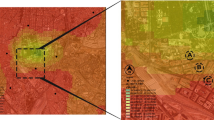Abstract
The variation in the atmospheric conditions of urban areas to the fringe areas is termed as urban heat island and is attributed predominantly to the differences in the pattern of built environment. The aim of this study is twofold; firstly, to assess the heat island intensity in the tropical city of Chennai through traverse method and secondly to establish the relationship between the built environment and its contribution in altering the microclimate parameters. Air temperature and relative humidity were measured across the city through traverse survey. The data were analyzed by generating temperature and relative humidity isopleths, and hotspots in the city were identified. Eight fixed stations were located in Thyagaraya Nagar—one of the identified hotspots to study the spatial distribution of climate parameters using ENVI-met simulations. The study confirms the presence of UHI in Chennai with an intensity of 4.5 °C in winter and 2.5 °C in summer. At the micro-scale level, the study establishes a difference of 6 °C during daytime. The study revealed a maximum physiological equivalent temperature (PET) difference of 22 °C between the locations. The findings of the study would enable urban planners to develop comfortable newer neighborhood with thermally comfortable outdoor environments which will help in increasing pedestrian comfort.














Similar content being viewed by others

References
Ali-Toudert, F., & Mayer, H. (2007). Effects of asymmetry, galleries, overhanging facades and vegetation on thermal comfort in urban street canyons. Solar Energy, 81(6), 742–754.
Amirtham, L. R. (2016). Urbanization and its impact on urban heat island intensity in Chennai Metropolitan Area, India. Indian Journal of Science and Technology, 9(5), 1–8.
Balling, R. C., Jr., & Cerveny, R. S. (1987). Long-term associations between wind speeds and the urban heat island of Phoenix, Arizona. Journal of Climate and Applied Meteorology, 26(6), 712–716.
Bornstein, R. D. (1968). Observations of the urban heat island effect in New York City. Journal of Applied Meteorology, 7(4), 575–582.
Campbell-Lendrum, D., & Corvalán, C. (2007). Climate change and developing-country cities: Implications for environmental health and equity. Journal of Urban Health, 84(1), 109–117.
Cardoso, R., Dorigon, L., Teixeira, D., & Amorim, M. (2017). Assessment of urban heat islands in small-and mid-sized cities in Brazil. Climate, 5(1), 14.
Census of India. (2011). District Census Handbook, Chennai Directorate of Census Operations Tamil Nadu.
Chow, W. T., & Roth, M. (2006). Temporal dynamics of the urban heat island of Singapore. International Journal of climatology, 26(15), 2243–2260.
De Abreu-Harbich, L. V., Labaki, L. C., & Matzarakis, A. (2015). Effect of tree planting design and tree species on human thermal comfort in the tropics. Landscape and Urban Planning, 138, 99–109.
Devadas, M. D., & Rose, A. L. (2009,). Urban factors and the intensity of heat island in the city of Chennai. In The seventh international conference on urban climate.
Eliasson, I. (1996). Intra-urban nocturnal temperature differences: A multivariate approach. Climate Research, 7(1), 21–30.
Emmanuel, R., & Johansson, E. (2006). Influence of urban morphology and sea breeze on hot humid microclimate: the case of Colombo, Sri Lanka. Climate Research, 30(3), 189–200.
Erell, E., & Williamson, T. (2007). Intra-urban differences in canopy layer air temperature at a mid-latitude city. International Journal of Climatology: A Journal of the Royal Meteorological Society, 27(9), 1243–1255.
Fong, C. S., Aghamohammadi, N., Ramakreshnan, L., Sulaiman, N. M., & Mohammadi, P. (2019). Holistic recommendations for future outdoor thermal comfort assessment in tropical Southeast Asia: A critical appraisal. Sustainable Cities and Society, 46, 101428.
Giridharan, R., Lau, S. S. Y., Ganesan, S., & Givoni, B. (2007). Urban design factors influencing heat island intensity in high-rise high-density environments of Hong Kong. Building and Environment, 42(10), 3669–3684.
Hathway, E. A., & Sharples, S. (2012). The interaction of rivers and urban form in mitigating the Urban Heat Island effect: A UK case study. Building and Environment, 58, 14–22.
Jamei, E., & Rajagopalan, P. (2019). Effect of street design on pedestrian thermal comfort. Architectural Science Review, 62(2), 92.
Jihad, A. S., & Tahiri, M. (2016). Modeling the urban geometry influence on outdoor thermal comfort in the case of Moroccan microclimate. Urban Climate, 16, 25–42.
Johansson, E., & Emmanuel, R. (2006). The influence of urban design on outdoor thermal comfort in the hot, humid city of Colombo, Sri Lanka. International Journal of Biometeorology, 51(2), 119–133.
Kikon, N., Singh, P., Singh, S. K., & Vyas, A. (2016). Assessment of urban heat islands (UHI) of Noida City, India using multi-temporal satellite data. Sustainable Cities and Society, 22, 19–28.
Kotharkar, R., & Bagade, A. (2018). Evaluating urban heat island in the critical local climate zones of an Indian city. Landscape and Urban Planning, 169, 92–104.
Mathew, A., Khandelwal, S., & Kaul, N. (2016). Spatial and temporal variations of urban heat island effect and the effect of percentage impervious surface area and elevation on land surface temperature: Study of Chandigarh city, India. Sustainable Cities and Society, 26, 264–277.
Matzarakis, A., Mayer, H., & Iziomon, M. G. (1999). Applications of a universal thermal index: Physiological equivalent temperature. International Journal of Biometeorology, 43(2), 76–84.
Mohan, M., Kikegawa, Y., Gurjar, B. R., Bhati, S., Kandya, A., & Ogawa, K. (2009). Assessment of urban heat island intensities over Delhi. In 7th International Conference on Urban Climate (pp. 1–4).
Montávez, J. P., Rodríguez, A., & Jiménez, J. I. (2000). A study of the urban heat island of Granada. International Journal of Climatology, 20(8), 899–911.
NCEI. (2020). Marine Station Details: VWFQ | Climate Data Online (CDO) | National Climatic Data Center (NCDC). Ncdc.noaa.gov. Retrieved 15 April 2020, from https://www.ncdc.noaa.gov/cdo-web/datatools/marine/detail/VWFQ
Oke, T. R. (1981). Canyon geometry and the nocturnal urban heat island: comparison of scale model and field observations. Journal of Climatology, 1(3), 237–254.
Oke, T. R. (1982). The energetic basis of the urban heat island. Quarterly Journal of the Royal Meteorological Society, 108(455), 1–24.
Oke, T. R. (1995). The heat island of the urban boundary layer: Characteristics, causes and effects. In J. E. Cermak, A. G. Davenport, E. J. Plate, & D. X. Viegas (Eds.), Wind Climate in Cities. NATO ASI Series (Series E: Applied Sciences) (Vol. 277). Dordrecht: Springer.
Oke, T. R., & Cleugh, H. A. (1987). Urban heat storage derived as energy balance residuals. Boundary-Layer Meteorology, 39(3), 233–245.
Port of Chennai, Chennai, n.d. The statement retrieved from https://chennaiport.gov.in/sites/all/themes/nexus/files/pdf/DOWNLOADS/np1-22a.pdf
Qaid, A., Lamit, H. B., Ossen, D. R., & Shahminan, R. N. R. (2016). Urban heat island and thermal comfort conditions at micro-climate scale in a tropical planned city. Energy and Buildings, 133, 577–595.
Ramakreshnan, L., Aghamohammadi, N., Fong, C. S., Ghaffarianhoseini, A., Wong, L. P., & Sulaiman, N. M. (2019). Empirical study on temporal variations of canopy-level Urban Heat Island effect in the tropical city of Greater Kuala Lumpur. Sustainable Cities and Society, 44, 748–762.
Regional Meteorological Centre, Chennai, n.d. The statement retrieved from http://www.imdchennai.gov.in/climate/chennai2.htm
Saaroni, H., Ben-Dor, E., Bitan, A., & Potchter, O. (2000). Spatial distribution and microscale characteristics of the urban heat island in Tel-Aviv, Israel. Landscape and Urban Planning, 48(1–2), 1–18.
Salata, F., Golasi, I., Petitti, D., de Lieto Vollaro, E., Coppi, M., & de Lieto Vollaro, A. (2017). Relating microclimate, human thermal comfort and health during heat waves: An analysis of heat island mitigation strategies through a case study in an urban outdoor environment. Sustainable Cities and Society, 30, 79–96.
Shang, C., Huang, X., Zhang, Y., & Chen, M. (2019). Outdoor thermal comfort in a tropical coastal tourist resort in Haikou, China. Indoor and Built Environment. https://doi.org/10.1177/1420326x19862337
Spangenberg, J., Shinzato, P., Johansson, E., & Duarte, D. (2008). Simulation of the influence of vegetation on microclimate and thermal comfort in the city of São Paulo. Revista da Sociedade Brasileira de Arborização Urbana, 3(2), 1–19.
Sun, S., Xu, X., Lao, Z., Liu, W., Li, Z., García, E. H., He, L., & Zhu, J. (2017). Evaluating the impact of urban green space and landscape design parameters on thermal comfort in hot summer by numerical simulation. Building and Environment, 123, 277–288.
Taha, H. (1997). Urban climates and heat islands: albedo, evapotranspiration, and anthropogenic heat. Energy and Buildings, 25(2), 99–103.
Taleghani, M., Kleerekoper, L., Tenpierik, M., & van den Dobbelsteen, A. (2015). Outdoor thermal comfort within five different urban forms in the Netherlands. Building and environment, 83, 65–78.
Tapper, N. J. (1990). Urban influences on boundary layer temperature and humidity: results from Christchurch, New Zealand. Atmospheric Environment: Part B—Urban Atmosphere, 24(1), 19–27.
Thomas, G., Sherin, A. P., Ansar, S., & Zachariah, E. J. (2014). Analysis of urban heat island in Kochi, India, using a modified local climate zone classification. Procedia Environmental Sciences, 21, 3–13.
Tyson, P. D., Du Toit, W. J. F., & Fuggle, R. F. (1972). Temperature structure above cities: review and preliminary findings from the Johannesburg urban heat island project. Atmospheric Environment, 6(8), 533–542.
Unger, J. (2004). Intra-urban relationship between surface geometry and urban heat island: review and new approach. Climate Research, 27(3), 253–264.
Yoshikado, H., & Tsuchida, M. (1996). High levels of winter air pollution under the influence of the urban heat island along the shore of Tokyo Bay. Journal of Applied Meteorology, 35(10), 1804–1813.
Zhang, K., Wang, R., Shen, C., & Da, L. (2010). Temporal and spatial characteristics of the urban heat island during rapid urbanization in Shanghai, China. Environmental Monitoring and Assessment, 169(1–40), 101–112.
Author information
Authors and Affiliations
Corresponding author
Additional information
Publisher's Note
Springer Nature remains neutral with regard to jurisdictional claims in published maps and institutional affiliations.
Rights and permissions
About this article
Cite this article
Rajan, E.H.S., Amirtham, L.R. Urban heat island intensity and evaluation of outdoor thermal comfort in Chennai, India. Environ Dev Sustain 23, 16304–16324 (2021). https://doi.org/10.1007/s10668-021-01344-w
Received:
Accepted:
Published:
Issue Date:
DOI: https://doi.org/10.1007/s10668-021-01344-w



